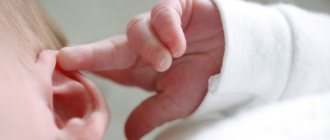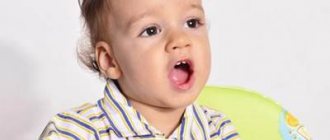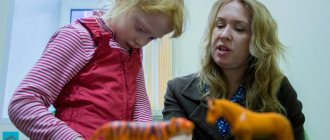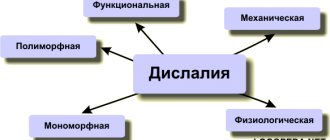Formation of praxis and dyspraxia in children
Developmental dyspraxia in children is the immaturity of voluntary object movements, as well as actions with a preserved intellectual level. When we talk about adults, a similar disorder that occurs after a stroke or traumatic brain injury is called apraxia (that is, the loss of already formed skills).
Let's list the childhood stages of motor development:
- Reflexes of a newborn;
- Formation of postural reactions, that is, maintaining balance and gradual verticalization (the child learns to hold his head, roll over, sit down, crawl, stand at a support, start walking and running);
- The inclusion of motor programs (crawling and walking are unconscious movements, a motor pattern, but, here, approaching an object, taking it and purposefully manipulating it is called praxis);
- Object-manipulative activity (initially unconscious, then increasingly voluntary);
- Imitation (from instincts to voluntary actions);
- Integration of stimuli received from sensory systems (proprioceptive, vestibular and kinesthetic information).
So, praxis (or voluntary movements) is based on: perception, as well as sensory integration. From the age of two we can already talk about the formation of primary praxis. According to Professor T.G. Wiesel (Doctor of Psychological Sciences), finger and manual praxis can be assessed from two and a half years of age. Oral praxis – from three years of age. From the age of four - articulatory.
Types of motor disorders in children
Violation of primary motor function (this is a violation of the elementary level of organization of movements, and not dyspraxia);
- Paresis - decreased muscle strength;
- Violation at the level of reflexes;
- Violation of tone (hypo-, hyper-, dystonia);
- Impaired balance, coordination, ataxia;
- Hyperkinesis (athetosis, chorea, tics, tremor).
Violation of sensorimotor function (we are talking about a higher level, in which it is necessary to combine several information flows and movement, that is, there is a chain of reactions “sensory input” and “motor output”):
- Difficulty with hand-eye coordination (for example, catching a ball);
- Sensory integration disorders (eg, underdevelopment of gross motor skills, gravitational uncertainty);
- Violation of the transition of the midline of the body;
- Synkinesia (unextinguished reflexes leading to the absence of differentiated, clear movements);
- Violation of bilateral coordination (impairments in interhemispheric interaction);
- Dysrhythmia.
Dyspraxia. This is already the highest level in the organization of the motor sphere. By mechanism:
- Kinesthetic dyspraxia (violation of posture, for example, articulatory posture to a particular sound or posture of fingers) - indicates that the lower parietal region of the left hemisphere is most often involved in the work;
- Kinetic or dynamic (expressed in a violation of the motor melody, the problem is observed in the switching of movement elements among themselves: switching when playing sounds, syllables, switching hand movements (for example, in the “fist-rib-palm” test) - the left premotor area of the cortex is more often involved Charles Njokiktjen, a Dutch neurologist, calls these levels “melokinetic dyspraxia” and says that this is not dyspraxia in the full sense, but a reflection of “lower” difficulties in the brain organization.
- Ideomotor dyspraxia – “true dyspraxia”, according to Njokiktien. Here the problem is different: “How to do it?”, namely a program of action. Localization - as in the previous case - premotor area, but in front of the kinetic + parieto-occipital areas of both hemispheres (depending on the type of activity).
- Ideatorial dyspraxia - “Why do?”, namely the plan of action containing intention. The prefrontal cortex is involved + all the required levels of praxis organization, which are described above, taking into account the content of the action.
You can also distinguish dyspraxia by type of activity: graphomotor, constructive, eating dyspraxia, dyspraxia of emotional expression, etc., but this is just a special case.
Types of dyspraxia by localization:
- Articulatory, verbal;
- Axial/postural;
- Oral-facial;
- Dyspraxia of the limbs, digital, manual.
Recommendations for parents for dyspraxia in children
Dyspraxia is a disorder of skill development. Training a specific skill, be it riding a bike or pronouncing sounds, will not eliminate dyspraxia. However, it is necessary to develop vital skills, and it is also very important to overcome the child’s psychological attitude of failure. Parents need to repeat the actions with the child many times, while encouraging him and removing the focus of attention from the action itself, so as not to focus on what he cannot do. Do not scold your child and, of course, do not compare with others. It is very important to lay the prerequisites for the formation of praxis, to engage in those types of activities that will put in order the “lower levels” of the organization of the motor sphere (trunk - vestibular nuclei - cerebellum - cortex).
Examples of activities: hemispheres, ortho-mats, jumpers, various balance beams, trampoline, balance bike, ball games, blind man's buff, hopscotch, catch-up, training methods with kinesiology balls and bags, swimming pool, roller skates, skating, AFK, exercise therapy, logorhythmics, kinesiology, drums, games to imitate movements (“try, repeat”, “mirror”), actions according to oral instructions (we break a complex action into parts and pronounce it step by step, as in the game “Robot”, complex ones can be in the form of a quest), development of new ways to use things and toys.
Features of praxis research
The study involves performing various tasks. A person is asked to perform several simple manipulations with the objects around him. The specialist also checks the recognition of these objects by sensory perceptions.
- First of all, the specialist establishes the ability to carry out simple manipulations. The person may be asked to close their eyes or stick out the tip of their tongue. The specialist may also ask the patient to make this or that figure with his fingers.
- After this, more difficult tasks follow. The specialist asks his client to comb his hair, light a match, or sprinkle salt on a piece of bread. Then comes the time for even more complex tests. The patient undertakes to imitate catching flies or hammering nails.
- Then the specialist begins to study transitive actions. To do this, the patient is asked to point a finger at his own eye or ear. At the last stage, the patient is asked to build a simple structure from cubes or matches.
Study of constructive praxis
The problem of studying the work activity of constructive praxis is becoming increasingly relevant. This is explained by the fact that the number of people with apraxia is increasing.
Early diagnosis contributes to both the success of therapy and the relief of secondary deposits.
A specialist who wants to explore constructive praxis usually resorts to “Build a Pyramid” techniques. Seguin board is also used. Almost always the board is used in a modified version, which involves the following steps:
- free mode;
- getting to know the figures;
- seating the figures in nests (this is done with only one hand).
The study is carried out with eyes closed. Before completing tasks, the specialist records the completion time of each mini-task. Of no small importance is what strategy the subject chooses.
This option allows the specialist to assess how both hemispheres of the brain interact with each other during stereognostic activity.
Also, to study constructive praxis, the specialist resorts to folding pictures. The test involves assembling a picture from 2 or 3 parts, cut vertically.
If the subject successfully completes the task, the researcher asks him to assemble a drawing from parts cut diagonally.
The next task seems a little more difficult. The subject is asked to put together a drawing using a pattern of two to four sticks. It is possible to perform this task from memory.
The specialist himself puts together the drawing, asks his ward to remember the order of actions, and then removes the sticks and offers to do the work from memory.
Study of kinesthetic praxis
Kinesthetic apraxia is formed against the background of damage to the middle and lower zones of the postcentral gyrus. In this case, a violation of the afferent synthesis of a voluntary motor act occurs. Therefore, the patient is deprived of the opportunity to correctly reproduce the postures of the upper limbs.
Without visual control, a person is not able to independently demonstrate how to fasten or comb their hair correctly.
The study of kinesthetic praxis occurs as follows. The doctor asks the subject:
- clench your hand into a fist;
- bare your teeth;
- stretch your lips into a tube;
- raise your tongue and puff out your cheeks.
After this, the specialist asks the subject to perform several manipulations with the brush. In this case, a consistent change in the posture of the hand is assumed.
The procedure is somewhat reminiscent of the famous children's game “Rock - Scissors - Paper”. The patient must first show the edge of the palm, then the palm, and then the fist. After testing one hand, it’s the second’s turn.
The next exercise is a little easier. The researcher invites his ward to bend and straighten the fingers several times, first on the left hand, and then on the right. This tests reciprocal coordination.
Other methods are also used. With the help of OKD, doctors can differentiate children with mental retardation from children with impaired intelligence.
Rate this article:
(votes: 1 , average: 5.00 out of 5)
Loading...
Related posts:
- Neurological diseases - types of apraxia and causes of their occurrence
- Kinesthetic (afferent) apraxia is a type of Lipmann apraxia
- Brief description of apraxias and their classification
- Articulatory (speech) apraxia is a variant of afferent apraxia
- Apraxia in children - how does this disease manifest?
- Treatment of apraxia - basic medical measures
Higher mental functions
Most likely, you will not come across this term in foreign scientific literature, however, I will use it to symbolize the functions of the cortex, which currently do not correspond to any associative or, especially, projection center. These are intellect, memory, will, imagination and others. Today, neuroscience believes that these functions do not have any specific corresponding area of the cortex, but are represented by many centers that are connected to each other by a huge number of fibers.
That is, the powerful intellect of a physics teacher or the incredible imagination of a movie director is not associated with any specific areas of the cortex. The point is that there are many connections between different parts of one hemisphere (associative fibers) or different hemispheres (commissural fibers).
This creates serious challenges for neurophysiologists and clinicians, since it is especially difficult to treat diseases with unknown localization. For example, many pathologies of thinking or perception still do not have any clear localization and doctors are trying to influence them almost by touch. However, advances in radiation diagnostics and molecular biology are gradually bringing us closer to clues. So today, many scientists are studying the biochemistry and anatomy of schizophrenia, approaching the day when this formidable crippling disease will be defeated.








